Abstract
Objective: To characterize the AMH levels in Puerto Rican women presenting to a fertility clinic. Methods: This was a cross-sectional study involving the acquisition of measured AMH levels from patient records dating October 2012- October 2014 (N=250). AMH levels determined by laboratory values were obtained. Data were stratified by age groups (25-29, 30-35, 35-39, 40+). Each dataset was represented as an AMH value at a single time point to determine median, mean and standard deviation for each group. Percentage of change for values were calculated comparing to previous corresponding age group and each group to 25-29 (subset 1) to evaluate declining trend. Results: A total of 250 records were evaluated. The data was segregated into 4 different age groups and their means, medians, and standard deviations were calculated individually. Age group 25-29 AMH values with a mean of 4.94, a standard deviation of 3.17, and a median of 4.75. Age group 30-34 AMH values: mean 4.30, standard deviation 5.63, and median 3.2. Age group 35-39 AMH values: mean 2.58, standard deviation 4.83, median 1.3. Age group 40 + AMH values: mean 1.29, standard deviation 1.54, median 0.85. Results showed a reduction of 47.7% and 73.8% when values of AMH were calculated for ages 35-39 and 40+ and compared to 25-29 years, respectively. Conclusion: The results demonstrate AMH levels among Puerto Rican women presenting to a fertility clinic supporting a decline of AMH with advancing age.
Authors who publish with this journal agree to the following terms:
a. Authors retain copyright and grant the journal right of first publication with the work simultaneously licensed under a Creative Commons Attribution License that allows others to share the work with an acknowledgement of the work's authorship and initial publication in this journal.
b. Authors are able to enter into separate, additional contractual arrangements for the non-exclusive distribution of the journal's published version of the work (e.g., post it to an institutional repository or publish it in a book), with an acknowledgement of its initial publication in this journal.
c. Authors are permitted and encouraged to post their work online (e.g., in institutional repositories or on their website) prior to and during the submission process, as it can lead to productive exchanges, as well as earlier and greater citation of published work (See The Effect of Open Access).
